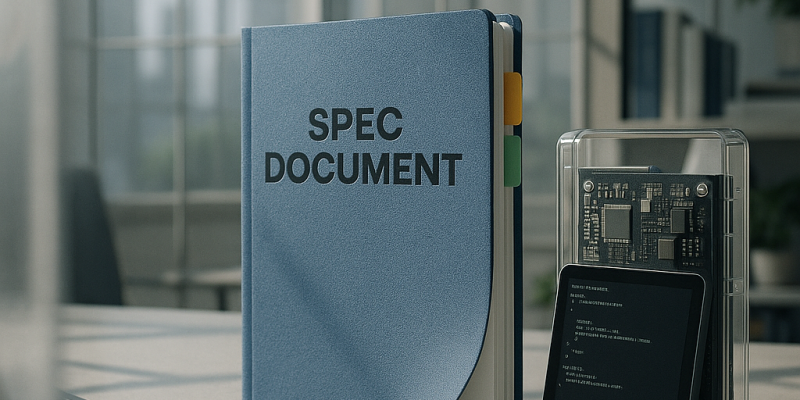Spec-Driven Development Is Going Mainstream — GitHub’s Spec Kit Leads
Published Nov 20, 2025
Tired of brittle AI code and lost prompt history? This brief tells you what changed, why it matters, and what to watch next. GitHub’s Spec Kit updated to v0.0.85 on 2025-11-15 and the spec-kit-plus fork advanced multi-agent templates (v0.0.17, 2025-10-28). Academics released SLD-Spec (2025-09-12) achieving 95.1% assertion correctness and ~23.7% runtime reduction for complex loops, and SpecifyUI (2025-09-09) introduced SPEC to improve UI fidelity. Why it matters: spec-first workflows promise faster first-pass correctness, clearer audits, and less tech debt but demand upfront governance, training and tooling—estimates show 20–40% feature overhead. Risks include spec ambiguity, model limits and growing spec/context complexity. Immediate actions: pilot Spec Kit templates, add spec review gates and monitor CI validation and real-world spec-as-source case studies. Confidence that SDD becomes mainstream in 12–18 months: ~80%.
Edge AI Meets Quantum: MMEdge and IBM Reshape the Future
Published Nov 19, 2025
Latency killing your edge apps? Read this: two near-term advances could change where AI runs. MMEdge (arXiv:2510.25327) is a recent on‐device multimodal framework that pipelines sensing and encoding, uses temporal aggregation and speculative skipping to start inference before full inputs arrive, and—tested in a UAV and on standard datasets—cuts end‐to‐end latency while keeping accuracy. IBM unveiled Nighthawk (120 qubits, 218 tunable couplers; up to 5,000 two‐qubit gates; testing late 2025) and Loon (112 qubits, six‐way couplers) as stepstones toward fault‐tolerant QEC and a Starling system by 2029. Why it matters to you: faster, deterministic edge decisions for AR/VR, drones, medical wearables; new product and investment opportunities; and a need to track edge latency benchmarks, early quantum demos, and hardware–software co‐design.
Rust Cuts Android Memory Bugs 1,000× — Faster Reviews, Fewer Rollbacks
Published Nov 18, 2025
Worried legacy C/C++ bugs are dragging down security and speed? Here’s what you need from Google’s Nov 13, 2025 data: Android platform memory-safety issues dropped below 20% of vulnerabilities, Rust shows a 1,000× lower vulnerability density versus C/C++, new Rust changes have 4× lower rollback rates and spend 25% less time in code review, and Rust is being used in firmware, kernel-adjacent stacks and parsers. A near-miss (CVE-2025-48530) in unsafe Rust was caught pre-release and was non‐exploitable thanks to the Scudo allocator, underscoring the need for training and unsafe‐code controls. Bottom line: memory safety is shifting from a checkbox to an engineering productivity lever—start embedding Rust in new systems code, tighten unsafe‐block governance, and track platform penetration, tooling, and policy adoption.
Google’s Antigravity Turns Gemini 3 Pro into an Agent-First Coding IDE
Published Nov 18, 2025
Worried about opaque AI agents silently breaking builds? Here’s what happened, why it matters, and what to do next: on 2025-11-18 Google unveiled Antigravity (public preview), an agent-first coding environment layered on Gemini 3 Pro (Windows/macOS/Linux) that also supports Claude Sonnet 4.5 and GPT-OSS; it embeds agents in IDEs/terminals with Editor and Manager views, persistent memory, human feedback, and verifiable Artifacts (task lists, plans, screenshots, browser recordings). Gemini 3 Pro previews in November 2025 showed 200,000- and 1,000,000-token context windows, enabling long-form and multimodal workflows. This shifts developer productivity, trust, and platform architecture—and raises risks (overreliance, complexity, cost, privacy). Immediate actions: invest in prompt design, agent orchestration, observability/artifact storage, and monitor regional availability, benchmark comparisons, and pricing.
WebAssembly at the Edge: Serverless Speed Without the Container Bloat
Published Nov 18, 2025
Struggling with slow serverless cold starts and bulky container images? Read on for a quick, actionable read: recent signals — led by the Lumos study (Oct 2025) — show WebAssembly (WASM)-powered, edge-native serverless architectures gaining traction, with concrete numbers, risks, and next steps. Lumos found AoT-compiled WASM images can be up to 30× smaller and reduce cold-start latency by ~16% versus containers, while interpreted WASM can suffer up to 55× higher warm-up latency and 10× I/O serialization overhead. Tooling like WASI and community benchmarks are maturing, and use cases include AI inference, IoT, edge functions, and low-latency UX. What to do now: engineers should evaluate AoT WASM for latency-sensitive components; DevOps must prepare toolchains, CI/CD, and observability; investors should watch runtime and edge providers. Flip to a macro trend needs major cloud/CDN SLAs, more real-world benchmarks and high-profile deployments; confidence today: ~65–75% within 6–12 months.
Retrieval Is the New AI Foundation: Hybrid RAG and Trove Lead
Published Nov 18, 2025
Worried about sending sensitive documents to the cloud? Two research releases show you can get competitive accuracy while keeping data local. On Nov 3, 2025 Trove shipped as an open-source retrieval toolkit that cuts memory use 2.6× and adds live filtering, dataset transforms, hard-negative mining, and multi-node runs. On Nov 13, 2025 a local hybrid RAG system combined semantic embeddings and keyword search to answer legal, scientific, and conversational queries entirely on device. Why it matters: privacy, latency, and cost trade-offs now favor hybrid and on‐device retrieval for regulated customers and production deployments. Immediate moves: integrate hybrid retrieval early, vet vector DBs for privacy/latency/hybrid support, use Trove-style evaluation and hard negatives, and build internal pipelines for domain tests. Outlook: ~80% confidence RAG becomes central to AI stacks in the next 12 months.
Rust, Go, Swift Become Non-Negotiable After NSA/CISA Guidance
Published Nov 18, 2025
One memory bug can cost you customers, downtime, or trigger regulation — and the U.S. government just escalated the issue: on 2025-11-16 the NSA and CISA issued guidance calling memory-safe languages (Rust, Go, Swift, Java, etc.) essential. Read this and you’ll get what happened, why it matters, key numbers, and immediate moves. Memory-safety flaws remain the “most common” root cause of major incidents; Google’s shift to Rust cut new-code memory vulnerabilities from ~76% in 2019 to ~24% by 2024. That convergence of federal guidance and enterprise pressure affects security posture, compliance, insurance, and product reliability. Immediate steps: assess exposed code (network-facing, kernel, drivers), make new modules memory-safe by default, invest in tooling (linting, fuzzing), upskill teams, and track migration metrics. Expect memory-safe languages to become a baseline in critical domains within 1–2 years (≈80% confidence).
Why Enterprises Are Racing to Govern AI Agents Now
Published Nov 18, 2025
By 2028 Microsoft projects more than 1.3 billion AI agents will be operational—so unmanaged agents are fast becoming a business risk. Here's what you need to know: on Nov. 18, 2025 Microsoft launched Agent 365 to give IT appliance‐like oversight (authorize, quarantine, secure) and Work IQ to build agents using Microsoft 365 data and Copilot; the same day Google released Gemini 3.0, a multimodal model handling text, image, audio and video. These moves matter because firms face governance gaps, identity sprawl, and larger attack surfaces as agents proliferate. Immediate implications: treat agents as first‐class identities (Entra Agent ID), require audit logs, RBAC, lifecycle tooling, and test multimodal risks. Watch Agent 365 availability, Entra adoption, and Gemini 3.0 enterprise case studies—and act now to bake in identity, telemetry, and least privilege.
Edge AI Revolution: 10-bit Chips, TFLite FIQ, Wasm Runtimes
Published Nov 16, 2025
Worried your mobile AI is slow, costly, or leaking data? Recent product and hardware moves show a fast shift to on-device models—and here’s what you need. On 2025-11-10 TensorFlow Lite added Full Integer Quantization for masked language models, trimming model size ~75% and cutting latency 2–4× on mobile CPUs. Apple chips (reported 2025-11-08) now support 10‐bit weights for better mixed-precision accuracy. Wasm advances (wasmCloud’s 2025-11-05 wash-runtime and AoT Wasm results) deliver binaries up to 30× smaller and cold-starts ~16% faster. That means lower cloud costs, better privacy, and faster UX for AR, voice, and vision apps, but you must manage accuracy, hardware variability, and tooling gaps. Immediate moves: invest in quantization-aware pipelines, maintain compressed/full fallbacks, test on target hardware, and watch public quant benchmarks and new accelerator announcements; adoption looks likely (estimated 75–85% confidence).
Agentic AI Workflows: Enterprise-Grade Autonomy, Observability, and Security
Published Nov 16, 2025
Google Cloud updated Vertex AI Agent Builder in early November 2025 with features—self‐heal plugin, Go support, single‐command deployment CLI, dashboards for token/latency/error monitoring, a testing playground and traces tab, plus security features like Model Armor and a Security Command Center—and Vertex AI Agent Engine runtime pricing begins in multiple regions on November 6, 2025 (Singapore, Melbourne, London, Frankfurt, Netherlands). These moves accelerate enterprise adoption of agentic AI workflows by improving autonomy, interoperability, observability and security while forcing regional cost planning. Academic results reinforce gains: Sherlock (2025‐11‐01) improved accuracy ~18.3%, cut cost ~26% and execution time up to 48.7%; Murakkab reported up to 4.3× lower cost, 3.7× less energy and 2.8× less GPU use. Immediate priorities: monitor self‐heal adoption and regional pricing, invest in observability, verification and embedded security; outlook confidence ~80–90%.









